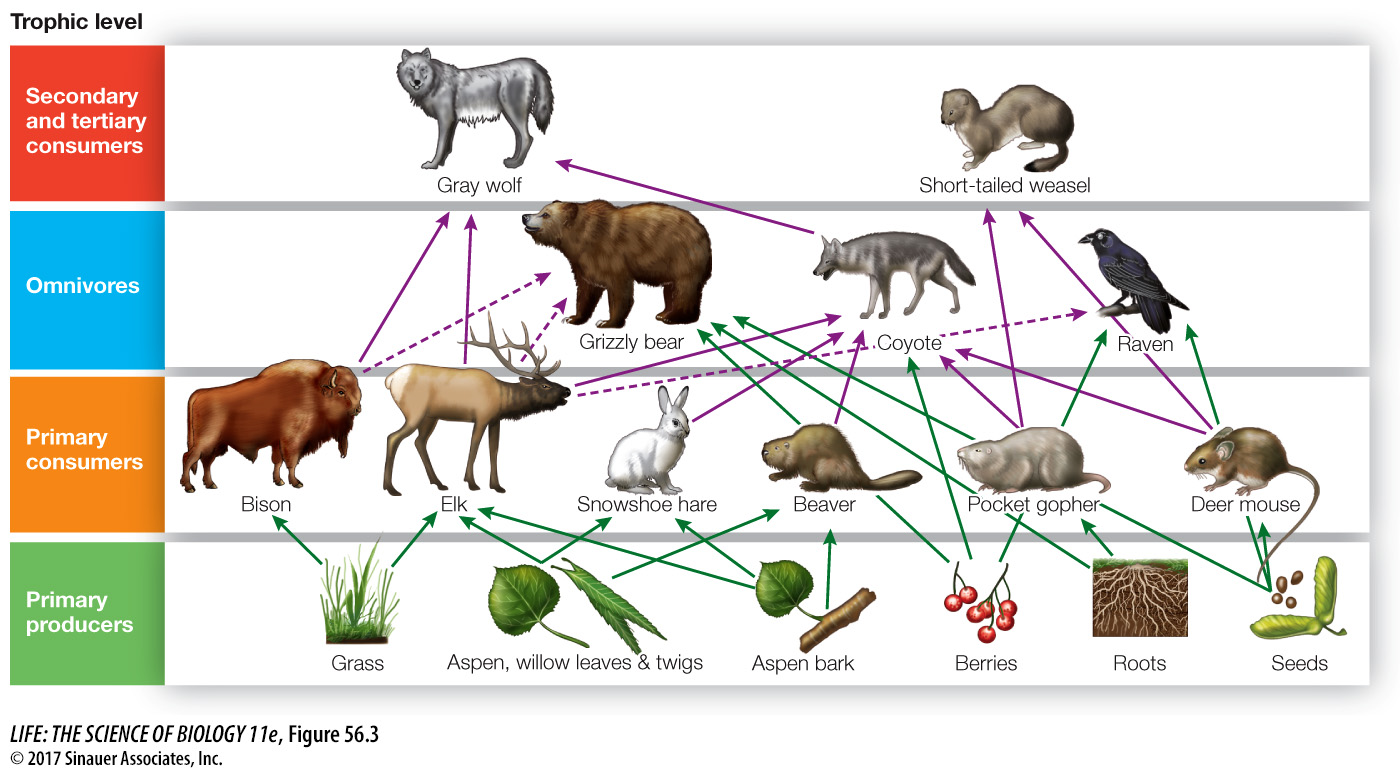Ecologists often use a subset of species to define communities
A community can be subdivided on the basis of taxonomic affinity—that is, by groups of organisms classified together because of evolutionary lineage (Figure 56.2A). For example, all the amphibians in a set of ponds on Mount St. Helens could be considered to be part of an amphibian community. A community can also be subdivided by resource usage. A guild is a group of species, often taxonomically distinct, that use similar resources (Figure 56.2B). For example, bats, birds, and bees all feed on pollen, forming a pollen-feeding guild. Yet another way to subdivide a community is by functional group—species that function in similar ways but may or may not use similar resources (Figure 56.2C). For example, nitrogen-fixing plants (legumes) can be placed in the same functional group.

Figure 56.2 Subsets of Species in Communities Ecologists often use subsets of species to define communities. (A) All the amphibian species in a community could be grouped together by taxonomic affinity. (B) All the species that use pollen as a resource form a guild. (C) All the legumes (e.g., vetch, clover, and peas) that have nitrogen-fixing bacteria could be placed in the same functional group. Species within functional groups may or may not use the same resources.
Ecologists also organize communities into a food web, a representation of the trophic or energetic connections among species, as illustrated in Figure 56.3 for Yellowstone National Park. Most communities contain so many species interacting in so many different ways that it is impossible to enumerate (or even identify) all of the links in a food web. Nevertheless, simplified food webs are useful in envisioning the kinds of interactions and sequence of energy flow occurring in a community. Food webs are generally divided by trophic levels, with each level including species that have similar ways of interacting and obtaining energy. Primary producers start the chain of trophic levels. At the next level are primary consumers—the herbivores that feed on primary producers. Organisms that eat herbivores, called secondary consumers, are the next trophic level. Those that eat secondary consumers are tertiary consumers, and so on. Some species, known as omnivores, feed on multiple trophic levels. For example, a bird might eat both insects and seeds. Finally, the waste products and dead bodies of organisms (known as detritus) provide another source of energy. Organisms that consume such materials are called detritivores or decomposers and serve an important function by returning nutrients back to the community through the uptake of primary producers. Scavengers eat larger dead organisms and are typically not considered detritivores.

Figure 56.3 Food Webs Show Trophic Interactions in a Community This simplified food web for the meadows and forests of Yellowstone National Park includes only some vertebrates and the plants on which they depend. The arrows show trophic interactions and energetic connections. Herbivores whose sole source of food is plants (green arrows) are primary consumers. Carnivores that kill and eat animals (purple arrows) are secondary and tertiary consumers. Omnivores such as grizzly bears, coyotes, and ravens eat both plant and animal tissues; ravens and grizzlies also eat carrion (dashed purple arrows), so these species are also scavengers.
Activity 56.1 The Major Trophic Levels
Food web depictions can sometimes include nontrophic interactions such as competition and positive interactions (mutualisms and commensalisms). These so-called interaction webs provide a more realistic view of all the species interactions that might be important in the community. Overall, the food web concept, regardless of whether it includes nontrophic interactions, is a useful visual representation of the important consumer relationships in a community. You will learn more about food webs later in this chapter and in Chapter 57.
Media Clip 56.1 A Food Web in Africa

